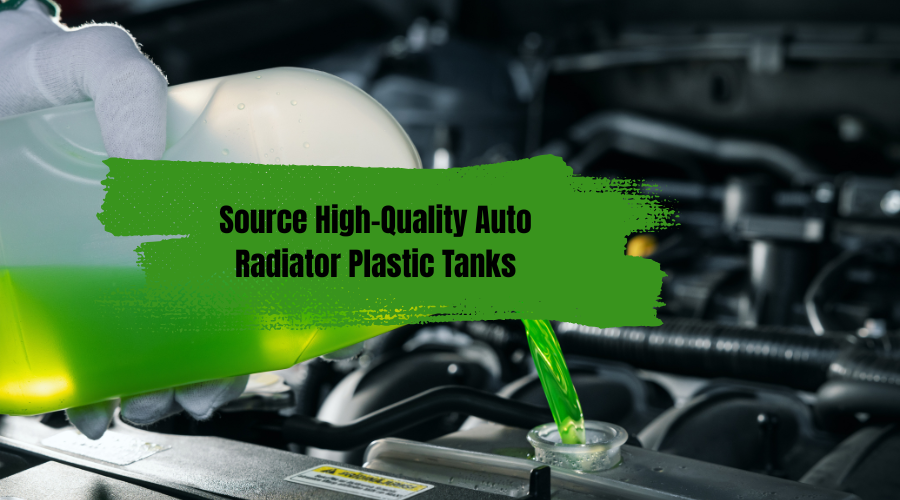

The process of locating the correct plastic tanks to use in an auto radiator seems like looking for a needle in a haystack. There are a lot of suppliers available in the market, so how do you get to know which suppliers will provide quality parts that you can count on? This blog will take you through everything you need to know about acquiring high-quality radiator plastic tanks for your business.
First, we will make a point about what distinguishes good radiator tanks from bad ones, and then we can move on to sourcing.
A good radiator plastic tank must not burst or warp under severe temperature conditions. It must be corrosion-resistant to coolant chemicals and sealed tightly against pressure. The highest-quality tanks are made from high-quality plastics, such as PA66 (nylon) or reinforced polypropylene. These items can withstand the heat cycles to which they are exposed by car engines every day. The low-quality, inexpensive tank plastics usually wear out, making them brittle and, hence, expensive to break down.
Search for tanks that have even, smooth surfaces and no defects, such as bubbles or jagged edges. Mounting points must be strong and well-reinforced. Keep in mind that at any given time, a radiator tank failure could find a customer on the roadside, and the quality of a tank should never be compromised.
The first step in your search should be to create a list of possible suppliers. Never select the first company you see on the web. Research on the options will be conducted at a later time. Check the years of experience and the other businesses they are engaged in.
A good supplier must possess a good history of manufacturing automotive parts. Seek suppliers of aradiator parts as opposed to suppliers who manufacture all types of plastics. Read customer reviews and testimonials, but be cautious when trusting them completely. Some individuals may be dishonest, while others may reflect unrealistic expectations.
When it comes to plastic, not all plastics are good, particularly those used in radiator tanks. This material must be able to withstand coolant temperatures of up to 200°F and remain flexible at freezing temperatures.
Glass-reinforced PA66 (Polyamide 66) hardware can be considered the gold standard for radiator tanks. This material exhibits excellent heat-resistant qualities, chemical compatibility, and durability. Other suppliers may propose lower-cost substitutes, such as regular polypropylene, which, however, does not work well under extreme conditions.
Suppliers should be asked to provide material certificates and test reports. This should include temperature resistance, chemical compatibility, and pressure testing of these documents. If a supplier is unable to provide such information, it should be considered a red flag.
Tank production encompasses both the quality aspect and the materials. The most widespread ones are injection molding, but the specifics are important. Enquire on the quality of the molds, injection pressure, and cooling.
High-quality manufacturers maintain precise temperatures during molding to prevent internal forces that could cause future cracking. They also use proper cooling cycles to ensure the plastic sets correctly in the tank wall.
A supplier of high-quality goods must have robust testing mechanisms. It is necessary to put a tank under pressure. Pressure testing is essential; tanks must be tested under pressure far greater than usual to ensure they will not fail under stressful situations. Temperature cycling tests are used to determine the potential harm caused by the expansion and contraction of materials.
Request them to show you their quality control paperwork. Good suppliers maintain good records of every batch of production, certifications of materials, and test results. They should be able to trace any tank in terms of its date of production and material lot. Other suppliers make other tests, such as vibration resistance tests or accelerated aging tests. Such tests are not always required, but they can give additional assurance in high-performance applications.
When you get a sufficient supplier, you should develop a strong relationship with them. Communicating regularly will help avoid misunderstandings and also alert you to any variations in their processes or materials.
Try visiting their facility if you are able. Visiting their operation will enable you to get firsthand information concerning their capabilities and quality levels. It also demonstrates to the supplier that you are in business.
Nevertheless, do not place all of your eggs in one basket. Backup suppliers will help you to continue production despite the difficulties with your primary supplier. Involve secondary suppliers by placing product orders periodically, as needed, to maintain demand.
Obtaining high-quality plastic radiator tanks is quite tiresome and time-consuming. Do not hurry and shorten the research. The money you will spend initially on identifying a suitable supplier will be rewarded by customer satisfaction and warranty costs.
Remember, the lowest price isn't always the best. Pay attention to suppliers that can appreciate your demands regarding quality and are consistent. Maintaining relationships with multiple suppliers ensures the supply chain remains resilient.
And last but not least, do not sacrifice quality and spend a few extra dollars. Failure of the radiator tank may lead to engine damage and leave the customer stranded. Your reputation is based on the quality of the parts you purchase, so select suppliers who share your commitment to quality and excellence.
The automotive industry is constantly evolving, with new technologies and materials continually
READ FULLMost of us don't think about our car’s radiator plastic tank until we have to. One day, eve
READ FULLThe process of locating the correct plastic tanks to use in an auto radiator seems like looking f
READ FULL